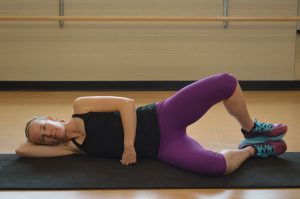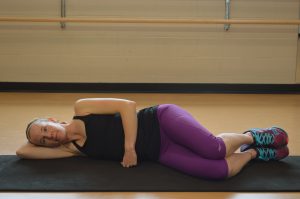As a distance runner, if you search for exercises, you can find a million different ideas of what you should be doing to run faster and to run healthy. One exercise that is comes up commonly is the clam. While it is simple to perform, there are specific reasons that I prescribe this exercise to patients, and why you may want to make this exercise part of your maintenance strengthening program.
To understand why you should spend a little time working the clam exercise, let’s give a little running gait terminology. (running gait: what your body is doing while you run to get from point A to point B). There are two main phases of the gait cycle: The stance phase and the swing phase.
The stance phase- the time when your foot is in contact with the ground
The swing phase- the time when your foot is in the air
In a research article published in 2007, the authors sought to discover which of several common rehabilitation exercises were able to activate the gluteal muscles while minimizing the activation of the tensor fascia lata (TFL). Here is a link to the full article: https://www.jospt.org/doi/pdf/10.2519/jospt.2007.2354
Why is this important? Let’s talk for a minute about the roles of the gluteal muscles and the TFL during running.
Gluteal muscles: The gluteal muscles are active throughout the stance phase of running. They help to stabilize the pelvis in order to prevent excessive stresses to the joint of the body. Also, the gluteal muscles are important with power and pushoff with each step.
TFL: While the TFL helps somewhat to stabilize the pelvis, it also is an internal rotator of the hip. Thus, during stance phase, it can cause rotation of the hip and lead to genu valgum, or the knees diving in toward one another. This gait mechanic can lead to injuries, particularly in the hips and knees. Also, during swing phase, an over dominant TFL will rotate the hip inward, which leads to a whip of the hip (the foot swings out and around instead of coming straight through.). This can be problematic for runners placing stress once again on the hip and knee joint as well as the fact that it is a less efficient way to run.
To sum it up: runners want to activate the gluteal muscles, without an excessive emphasis on the TFL.
So, what did the researchers discover? They found that the clam exercise was the most specific exercise to target the gluteal muscles while minimizing the activation of the TFL. This exercise was significantly more specific than the others, though the single leg bridge, side stepping, and quadruped hip extension exercises were also fairly specific to the gluteal muscles.
Here is how it is done:
Clams: Begin on your side, with your knees bent and drawn up toward your chest. Lock your heels together and rotate the top leg open. Make sure that your hip remains forward and does not roll back as you lift your leg. Complete 20-30 times on each side.


Would you like to learn about more exercises to keep yourself running pain-free? Check out my ebook!
